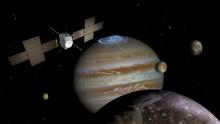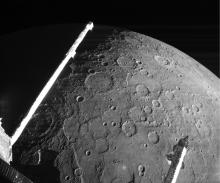Listen to today's episode of StarDate on the web the same day it airs in high-quality streaming audio without any extra ads or announcements. Choose a $8 one-month pass, or listen every day for a year for just $30.
You are here
JUICE III
When the JUICE mission begins its trek to Jupiter later this month, it’ll be launched by one of the most powerful rockets on the planet, Ariane 5. And the probe carries more than three tons of propellants. Even so, it’ll need a lot of help to reach Jupiter, and to achieve its scientific goals.
JUICE is scheduled to enter orbit around Jupiter in 2031. But it can’t get there on its own. So as it loops around the Sun, it’ll stage some close encounters — three with Earth, and one each with the Moon and Venus. JUICE will “steal” a tiny bit of energy during each pass. That will give it a gravitational “kick,” which will boost its speed and sculpt its path.
The mission’s main goal is to orbit Ganymede, the solar system’s biggest moon. It appears to have a deep ocean of liquid water far below its surface. The ocean could be a habitat for life. And even if it’s not, studying Ganymede will tell us more about how Jupiter’s big moons formed, how they’re put together, and how they’re changing.
But JUICE will need more help to enter that orbit. It will stage more than two dozen flybys of Ganymede and Jupiter’s other big icy moons, Callisto and Europa — important targets on their own. JUICE will use each moon’s gravity to refine its path — like getting a free rocket burn with each pass. That will ensure that it reaches Ganymede at just the right time, angle, and speed — when it can use its own power to settle into orbit.
Script by Damond Benningfield





